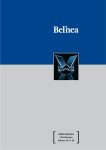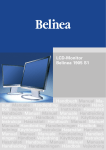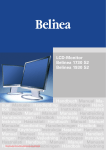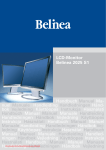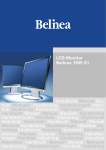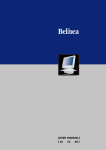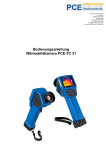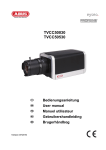Download MAXDATA Belinea 101725 User manual
Transcript
Austria MAXDATA Computer GmbH Ignaz-Köck-Straße 9 • A-1210 Wien Benelux MAXDATA Benelux B.V. Bredaseweg 113-115 • NL-4872 LA Etten-Leur Germany MAXDATA Computer GmbH & Co. KG Elbestraße 12-16 • D-45768 Marl France MAXDATA S.A.R.L. 1, rue du Gevaudan • SILIC 1726 F-91017 EVRY Cedex Italy MAXDATA Italia S.r.l. Strada 1, Palazzo F1 I-20090 Milanofiori, Assago (MI) Poland MAXDATA Sp. z o.o. Ursynów Business Park Ul. Puławska 303 • PL-02-785 Warszawa Spain • Portugal MAXDATA Iberia C/Collado mediano, s/n • Edificio Prisma Portal 1 - Pta. 1a B • E-28230 - Las ROZAS, Madrid Switzerland MAXDATA Computer AG Haldenstrasse 5 • CH-6340 Baar MAXDATA UK Limited The MAXDATA Centre • Downmill Road Bracknell, Berkshire RG12 1QS • UK www.maxdata.com Art. No.: 11 17 28 United Kingdom USER MANUAL TFT-Monitor Belinea 10 17 10 BELINEA PREMIUM SERVICE English The three-year return to base warranty for your Belinea monitor includes all parts and labour. In addition many countries offer a free of charge swap out warranty programme. This does not affect your Statutory Rights. Please visit http://www.belinea.com or call the numbers below for further warranty or service information. Please have the serial and model number ready when calling. Deutsch Die Garantie für Ihren Belinea Monitor beträgt drei Jahre und umfasst alle Bauteile. Darüber hinaus bieten wir in vielen Ländern einen zusätzlichen, kostenlosen Austausch-Service an. Von dieser o. g. Garantie bleiben etwaige gesetzliche Gewährleistungsrechte unberührt. Nähere Informationen zu Garantie- und Servicefragen erhalten Sie im Internet unter http://www.belinea.com sowie unter den u. g. Rufnummern. Bitte halten Sie für Ihren Anruf Serien- und Modellnummer bereit. Français La garantie internationale de trois ans sur les écrans Belinea s’entend pièces et main d’œuvre. Pour obtenir plus d’informations sur la garantie et le service après-vente contactez-nous sur Internet http://www.belinea.com ou aux numéros de téléphone ci-dessous. Vous pouvez obtenir également plus de détails sur les possibilités d’échange gratuit, service offert dans de nombreux pays. Pour votre appel, tenez les numéros de série et d’article à portée de main. Country Land Pays Phone number Telefonnummer Numéro de téléphone Additional swap out service Zusätzlicher Austausch-Service Service supplémentaire d’échange sur site Belgie/Belgique 0900 10630 (0,45 €/min) 3 year on-site warranty (swap out) Deutschland 02365 952 1010 3 Jahre Garantie-Austausch-Service España 090 21 96 497 3 años de garantia con intercambio a domicilio Ελλαδα 01 02 40 91 50 Εγγυηση 3 χρονια επιτοπου αντικατασταση France 0820 091820 3 ans de garantie avec échange standard sur site Italia 02 38 20 20 79 3 anni di Garanza di sostituzione a domicilio Ireland 00 353 12861343 3 year on-site warranty (swap out) Luxemburg/Luxembourg 0900 74235 (0,45 €/min) 3 year on-site warranty (swap out) Magyarország 01 340 99 51/53 3 év helyi szerviz Nederland 0900 BELINEA (02354632) (0,70 €/Gesprek) 3 year on-site warranty (swap out) Österreich 01 277 89 88 3 Jahre Vor-Ort-Austausch-Garantie Polska 071 337 19 55/022 863 27 77 3 lata gwarancji (door to door). Portugal 0 21 771 36 00 3 Anos de Troca em Garantia On-Site Ðîññèÿ +49 (0) 180 5 62 94 68 Òðåõëåòíÿÿ ãàðàíòèÿ ñ çàìåíîé íà ðàáî÷åì ìåñòå Schweiz 0900 575 111 (2,13 CHF/min) 3 Jahre Vor-Ort-Austausch-Service United Kingdom 01344 788920 3 year on-site swap out warrant (UK mainland only) All other countries Alle anderen Länder Les autres pays +49 (0) 180 5 62 94 68 BELINEA 10 17 10 DEUTSCH 2-8 ENGLISH 9 - 14 FRANÇAIS 15 - 20 Revision 1.1 DEUTSCH WILLKOMMEN BEI BELINEA Herzlichen Glückwunsch zu Ihrem neuen Belinea-Monitor. Sie haben sich für einen innovativen Hersteller entschieden, der High-Tech-Monitore mit sehr hohem Qualitätsniveau fertigt. Wir sind sicher, dass dieser Monitor Ihre Erwartungen erfüllt und dass Sie mit ihm einen zuverlässigen Partner gewinnen. Computer und Monitore sind aus dem heutigen Alltag kaum mehr wegzudenken. Als Schnittstelle zwischen Mensch und Technik kommt dabei dem Monitor eine besondere Bedeutung zu. Dessen sind wir uns bewusst, und wir setzen dies konsequent in den Grundwerten unserer Produktphilosophie um: Qualität Die hohe Qualität unserer Monitore wird von uns ständig überprüft. Sie ist nicht einfach nur ein Versprechen, sondern wird durch umfangreiche Spezifikationen und zahlreiche Zertifizierungen bestätigt. Das Ergebnis ist eine hervorragende Bildqualität und Farbbrillanz bei allen Belinea-Modellen. Zuverlässigkeit Die bei Belinea-Monitoren eingesetzten Technologien bringen Qualität und Aktualität miteinander in Einklang. Eine umfangreiche Prüfung der Geräte sorgt dafür, dass nur ausgereifte Technologien ins Programm genommen werden. Das führt zu äußerst geringen Ausfallraten und besonders langlebigen Produkten. Ergonomie Bei all unseren Entwicklungen steht immer eines im Vordergrund: Der Mensch, der am Monitor arbeitet. Unsere Arbeit soll ihm seine leichter machen. Daher sind Belinea-Monitore fast ausschließlich nach den strengsten Ergonomie-Normen wie z. B. TCO und TÜV Ergonomie zertifiziert und sorgen so für ein durch und durch angenehmes Arbeiten. Service Ob man bei der Wahl des Monitors die richtige Entscheidung getroffen hat, weiß man spätestens, wenn man den Service benötigt. Deshalb bieten wir in vielen europäischen Ländern einen umfassenden Garantie-Austausch-Service an, der sowohl die Bildröhre als auch das Panel und Backlight umfasst. ALLGEMEINE EIGENSCHAFTEN VON LC-DISPLAYS Bildperformance Technologisch bedingt bieten LC-Displays eine äußerst scharfe Bilddarstellung ohne geometrische Verzerrungen sowie eine hervorragende Leuchtkraft für eine brillante Bildperformance. Minimierte Reflexionen resultieren aus der flachen Paneloberfläche sowie entsprechenden Beschichtungen. Gesundheit Die geringe elektromagnetische Strahlung von LCDs schont Ihre Gesundheit. Design Die geringe Stellfläche eines LC-Displays kommt der Arbeitsfläche auf Ihrem Schreibtisch zugute, und aufgrund des geringen Gewichts kann das Display problemlos von einem Einsatzort zum nächsten transportiert werden. Das attraktive Design der Geräte macht sie darüber hinaus zu einem Blickfang an jedem Arbeitsplatz. Wirtschaftlichkeit Der niedrige Energiebedarf ist ein wesentlicher Vorteil eines LC-Displays (LCD). So verbraucht ein LCD im Durchschnitt ca. 50 % weniger Energie als ein CRT-Monitor mit einer vergleichbaren sichtbaren Bilddiagonale. 2 - Belinea 10 17 10 DEUTSCH EINLEITUNG INHALTSVERZEICHNIS Dieses Handbuch wird Sie mit der Installation und der Bedienung des Belinea-Monitors vertraut machen. Sehen Sie diese Anleitung auch dann kurz durch, wenn Ihnen die Bedienung eines Monitors bereits vertraut ist. WILLKOMMEN BEI BELINEA..................................... 2 Wir haben alle Sorgfalt walten lassen, um in diesem Handbuch korrekte und akkurate Informationen zu geben. Für möglicherweise vorhandene Fehler kann jedoch keine Haftung übernommen werden. Weiterhin übernehmen wir keine Garantie dafür, dass die Hardware den von Ihnen gewünschten Zweck erfüllt. Für Hinweise auf vorhandene Fehler, Ihre Verbesserungsvorschläge und Kritik sind wir stets dankbar. © Copyright 2004 MAXDATA Systeme GmbH 45768 Marl, Deutschland www.maxdata.com Redaktion, Grafik und Übersetzung: think’Z GmbH, www.thinkz.de Alle Rechte vorbehalten. Kein Teil dieses Handbuchs darf in irgendeiner Form (Druck, Fotokopie, Mikrofilm oder andere Verfahren) ohne vorherige schriftliche Genehmigung des Herstellers reproduziert oder unter Verwendung elektronischer Systeme verarbeitet, vervielfältigt oder verbreitet werden. ALLGEMEINE EIGENSCHAFTEN VON LC-DISPLAYS .................................................... 2 EINLEITUNG .............................................................. 3 WICHTIGE HINWEISE ............................................... 4 WARTUNG UND PFLEGE .......................................... 4 AUSPACKEN .............................................................. 5 ANSCHLIESSEN ........................................................ 5 EINSCHALTEN ........................................................... 5 KONFIGURIEREN ...................................................... 6 GRUNDLEGENDE EINSTELLUNGEN ....................... 6 BILDEINSTELLUNG ÜBER DAS OSD-MENÜ .......... 6 FUNKTIONEN DES OSD-MENÜS ............................. 7 PROBLEMLÖSUNGEN .............................................. 8 TECHNISCHE DATEN ................................................ 8 Änderungen, die dem technischen Fortschritt dienen, bleiben vorbehalten. Belinea ist ein international eingetragenes Warenzeichen. Andere Markennamen können eingetragene Warenzeichen sein und müssen als solche behandelt werden. Verwendung von Symbolen In diesem Handbuch werden folgende Symbole verwendet, um auf eine mögliche Personengefährdung, Sachschäden bzw. nützliche Informationen hinzuweisen: GEFAHR! Bezeichnet eine mögliche Gefährdung des Anwenders. Bei Nichtbeachtung können Tod oder schwerste Verletzungen die Folge sein. ACHTUNG! Weist auf mögliche Sachschäden hin. Bei Nichtbeachtung können Geräte ernsthaft beschädigt werden. WICHTIG! Bezeichnet Anwendungstipps und andere besonders nützliche Informationen. Umweltschutz ist auch unsere Aufgabe: Dieses Handbuch wurde von der ersten bis zur letzten Seite auf einem Papier gedruckt, bei dessen Herstellung keinerlei Chlor mehr verwendet wird. Bedienungsanleitung - 3 DEUTSCH WICHTIGE HINWEISE Hinweise zum Aufstellungsort • Der Aufstellungsort darf weder extrem heiß oder kalt noch feucht oder staubig sein. Hitze und Kälte können die Funktionsfähigkeit des Monitors beeinträchtigen. Feuchtigkeit und Staub können zu einem Ausfall des Monitors führen. • Stellen Sie den Monitor nicht in unmittelbarer Nähe von Wärmequellen wie Heizkörpern oder Radiatoren auf. Das Gerät darf zudem keinen mechanischen Vibrationen oder Stößen ausgesetzt sein. • Stellen Sie den Monitor so auf, dass kein direktes Licht oder Sonneneinstrahlung auf die Bildschirmoberfläche fällt. Andernfalls können Spiegelungen entstehen, so dass die Bildbrillanz beeinträchtigt wird. • Achten Sie darauf, dass die Lüftungsschlitze nicht verdeckt werden. Die Luftzirkulation im Monitor ist erforderlich, um eine Überhitzung zu vermeiden. Wird sie beeinträchtigt, können Brand oder ein Ausfall des Monitors die Folge sein. • Verwenden Sie zum Reinigen des Monitors keine Lösungsmittel, da andernfalls die Gehäuseoberfläche beschädigt werden kann. Weitere Hinweise zur Pflege des Geräts finden Sie im Abschnitt „Wartung und Pflege“. Öffnen Sie den Monitor niemals eigenständig. Andernfalls besteht die Gefahr eines Stromschlags oder anderer Personenschäden. Der Monitor darf nur von Fachpersonal geöffnet und gewartet werden. Hinweise zur Auflösung Hinweise zum Netzanschluss Alle von der Grafikkarte gelieferten Auflösungen, die von der physikalischen Auflösung des Panels abweichen, werden durch Interpolation angepasst. Eine Beeinträchtigung der Bildqualität ist hierbei möglich. Verwenden Sie ausschließlich das für Ihr Land geeignete Netzkabel. Die Netzsteckdose sollte sich in direkter Nähe befinden und leicht zugänglich sein. Der Monitor kann nur durch Ziehen des Netzsteckers aus der Steckdose ganz vom Netz getrennt werden. • Hinweise zur Ergonomie Um Ihre Augen, Nacken- und Schultermuskulatur bei der Arbeit am Bildschirm zu schonen, empfehlen wir, einen Augenabstand von 50 bis 75 cm zum Monitor einzuhalten. Darüber hinaus können die Augen durch regelmäßiges Fixieren eines Gegenstandes in etwa 6 m Entfernung entspannt werden. Sie erreichen eine ergonomische Sitzhaltung, wenn Ellbogen, Be cken, Knie und Fußgelenke jeweils einen rechten Winkel bilden. Dieser Monitor ist ENERGY STAR ® -kompatibel. MAXDATA versichert als ENERGY STAR ® -Partner, dass dieses Gerät den ENERGY STAR ® Richtlinien zur Optimierung des Stromverbrauchs entspricht. Sicherheitshinweise zum Betrieb Das Netzkabel darf nicht beschädigt werden. Stellen Sie keine Gegenstände auf das Netzkabel, und sorgen Sie dafür, dass keine Knoten am Kabel auftreten. Um das Kabel zu lösen, ziehen Sie stets am Stecker und nie am Kabel selbst. Ein beschädigtes Netzkabel kann zu Brand oder Stromschlägen führen. WARTUNG UND PFLEGE • Lösen Sie zuerst das Netzkabel von der Stromversorgung, indem Sie den Stecker aus der Steckdose ziehen. • Reinigen Sie den Monitor bei leichter Verschmutzung nur mit einem trockenen, weichen und antistatischen Tuch. • Reinigen Sie die Bildfläche äußerst vorsichtig und nur mit einem weichen Tuch, da ansonsten die LCD-Oberfläche Schaden nehmen kann. Wenn das Monitorgehäuse stark verschmutzt ist, reinigen Sie es mit einem feuchten Tuch. Verwenden Sie nur warmes Wasser (keine Lösungsmittel), und reiben Sie den Monitor anschließend trocken. Durch Lösungsmittel oder andere scharfe Reinigungsmittel kann die Gehäuseoberfläche beschädigt werden. • Die vorderseitige LCD-Bildschirmfläche ist sehr empfindlich! Vermeiden Sie daher jeglichen Druck auf die Bildfläche (Finger, Stift usw.), und gehen Sie besonders beim Transportieren des Geräts vorsichtig vor, damit der Bildschirm keinen starken Stößen ausgesetzt wird und keine Kratzer entstehen (verwenden Sie stets die Originalverpackung). 4 - Belinea 10 17 10 DEUTSCH AUSPACKEN Heben Sie den Monitor vorsichtig aus der Verpackung, und überprüfen Sie das Zubehör auf Vollständigkeit (siehe Abbildung 1). Netzkabel Bewahren Sie den Originalkarton und das Verpackungsmaterial für den Fall auf, dass Sie den Monitor einschicken oder anderweitig transportieren müssen. Audiokabel ± Montage des Monitorfußes ...................................... 1. Legen Sie den Monitor zum Anbringen des Standfußes mit der Vorderseite auf eine flache Unterlage. VGA-Kabel 2. Klappen Sie den Ständer nach oben, und schieben Sie den Fuß auf den Ständer, bis er hörbar einrastet. MENU SELECT AUTO 3. Schwenken Sie den installierten Fuß anschließend ganz heraus, damit Sie das Gerät aufstellen können. VOLUME MUTE Abbildung 1. LCD-Monitor ANSCHLIESSEN ± Schließen Sie den Monitor an den PC an............... 1. Stellen Sie sicher, dass Ihr PC und der Monitor vom Netz getrennt sind. 2. Schließen Sie das 15-polige Signalkabel an den Monitor und an den PC an (siehe Abbildung 2). 2 AC-IN AC-IN D-SUB 3 1 D-SUB Signalkabel Abbildung 3. Stromversorgung anschließen ± Audioanschluss ........................................................ Wenn Ihr Computer über einen Audioausgang verfügt, schließen Sie das mitgelieferte Audiokabel an die Audioeingangsbuchse des Monitors ( in Abb. 3) und die Line-Out-Buchse des PC an. Abbildung 2. Monitor an den PC anschließen ± Schließen Sie die Stromversorgung an ................. Schließen Sie das separate Netzkabel an den Monitor ( in Abb. 3) und eine Schuko-Steckdose an. ± Kopfhöreranschluss ................................................. Sie können einen Kopfhörer direkt an den Monitor ( in Abb. 3) anschließen. EINSCHALTEN 1. Schalten Sie zuerst den PC und anschließend den Belinea-Monitor mit der Netztaste ( in Abb. 4) ein. Die Betriebsanzeige ( in Abb. 4) leuchtet grün auf. Einstellungen“ und „Bildeinstellung über das OSDMenü“). 3. Wird auf dem Monitor kein Bild angezeigt, lesen Sie die Infos im Abschnitt „Problemlösungen“. 2. Stellen Sie das Bild gemäß Ihren Anforderungen ein (siehe die nachstehenden Abschnitte „Grundlegende Bedienungsanleitung - 5 DEUTSCH KONFIGURIEREN ± Monitor unter Windows ® 9x/ME/2000 und XP konfigurieren: Um den Monitor unter Windows ® 9x/ME/2000 und XP in Betrieb zu nehmen, wird dringend empfohlen, die Belinea-Einstellungsdatei zu installieren. Sie können diese über Ihren Belinea-Händler beziehen oder vom MAXDATA FTP-Server ftp.maxdata.com laden. Wählen Sie hier die Rubrik „Belinea_Treiber_Driver“, und laden Sie die Dateien Belinea.inf und README _ Belinea.TXT herunter. Befolgen Sie die Installationsanweisungen in der Datei README_ Belinea.TXT. ± Monitor unter Windows ® NT 4.0 konfigurieren: Unter Windows ® NT 4.0 benötigen Sie keine separate Einstellungsdatei. Wählen Sie die Bildwiederholfrequenz und Anzahl der Farben direkt unter den Menüpunkten „Einstellungen“ „Systemsteuerung“ „Anzeige“ „Einstellungen“ aus. GRUNDLEGENDE EINSTELLUNGEN ➧ Automatische Bildjustierung ................................... ± Ton stummschalten (MUTE) .................................... Sie können die Bildeinstellungen (wie Bildposition, Phase usw.) entweder manuell einstellen oder die automatische Justierungsfunktion des LCD-Monitors verwenden. Hiermit werden die einzelnen Bildparameter auf die optimalen Werte für den aktuellen Grafikmodus eingestellt. Drücken Sie zum Aufrufen der automatischen Justierung die Taste SELECT/AUTO ( in Abb. 4). Warten Sie kurz, bis die automatische Justierung abgeschlossen ist. Sie können die Tonwiedergabe stummschalten oder aktivieren, indem Sie die Taste MUTE ( in Abb. 4) drücken, während das OSD-Menü nicht angezeigt wird. ± Lautstärke direkt einstellen ..................................... Sie können die Lautstärkewiedergabe des integrierten Audiosystems direkt einstellen, indem Sie die Taste VOLUME ( in Abb. 4) drücken, während das OSDMenü nicht angezeigt wird. Drücken Sie anschließend die Taste oder ( und in Abb. 4), um die Lautstärke zu reduzieren oder um sie zu erhöhen. BILDEINSTELLUNG ÜBER DAS OSD-MENÜ Das OSD-Menü ist ein Fenster, in dem Sie die aktuellen Bildeinstellungen einsehen und ändern können. Es wird folgendermaßen aufgerufen: 1. Drücken Sie die OSD-Taste MENU ( in Abb. 4). Das OSD-Menü wird auf dem Bildschirm angezeigt. 2. Es gibt insgesamt 10 verschiedene, nach Kategorien gegliederte OSD-Untermenüs. Wählen Sie durch Drücken der OSD-Taste oder ( und in Abb. 4) die gewünschte Kategorie (siehe Abschnitt „Funktionen des OSD-Menüs“). MENU 1 2 VOLUME MUTE 3 4 5 Abbildung 4. Bedienelemente des Monitors 6 - Belinea 10 17 10 4. Wenn Sie ein Untermenü aufgerufen haben, so wählen Sie erneut mit den OSD-Tasten oder ( und in Abb. 4) die gewünschte Unterfunktion aus. 5. Stellen Sie ggf. mit den OSD-Tasten oder ( und in Abb. 4) den gewünschten Wert ein. Die neuen Einstellungen werden sofort wirksam. 6. Wiederholen Sie ggf. die Schritte 2–5, um weitere Einstellungen vorzunehmen. 7. Das OSD-Menü wird automatisch ausgeblendet, nachdem ca. 10 Sekunden lang (Standardeinstellung) keine Bedienung erfolgt ist. Dabei werden die aktuellen Einstellungen gespeichert. Sie können es aber auch manuell ausblenden, indem Sie die Taste MENU ( in Abb. 4) drücken. SELECT AUTO 3. Drücken Sie die OSD-Taste SELECT/AUTO ( in Abb. 4), um die ausgewählte Funktion bzw. das dazugehörige Untermenü zu aktivieren. 6 DEUTSCH FUNKTIONEN DES OSD-MENÜS 1280 x 1024 H : 64.0 V : 60.0 BRIGHTNESS ETC Brightness Regelt die Helligkeit des Bildes. Contrast Regelt den Kontrast des Bildes. Color Control Color Control: Es sind drei verschiedene Farbtemperatureinstellungen verfügbar: User (Benutzer), Bluish (Blau) und Reddish (Rot). Drücken Sie zum Auswählen der gewünschten Einstellung die Taste oder . User: Sie können eine benutzerdefi nierte Ein stellung der RGB-Farbanteile vornehmen. Drücken Sie zum Auswählen von Red (Rot), Green (Grün) oder Blue (Blau) die Taste oder und anschließend die Taste SELECT/AUTO. Position H Position: Regelt die horizontale Position des Bildes. V Position: Regelt die vertikale Position des Bildes. Clock Phase Phase: Anpassen der Verzögerung des internen Takts zur Optimierung der Bilddarstellung. ETC Miscellaneous Recall: Stellt die werkseitigen Bildeinstellungen wieder her. OSD Time: Bestimmt, nach welcher Zeit (in Sekunden) das OSD-Menü automatisch beendet werden soll, soweit keine Änderung erfolgt ist. OSD Position: Regelt die horizontale bzw. vertikale Position des OSD-Menüs. Auto Color Auto Color: Automatische Farbeinstellung. Language Language: Wählt die Sprache des OSD-Menüs: Englisch, Spanisch, Deutsch, Französisch, Italienisch, Schwedisch, Finnisch, Dänisch, Portugiesisch, Niederländisch, Koreanisch, Japanisch, Chinesisch. Audio Volume: Stellt die Wiedergabelautstärke der Monitorlautsprecher ein. Wählen Sie über die Tasten oder die gewünschte Lautstärke. Audio On/Off: Sie können die Tonwiedergabe stummschalten oder den Ton wieder einschalten. Auto Adjust Stellt automatisch die optimalen Werte für die Bildeinstellungen (Bildposition, Phase usw.) ein. Clock: Zum Einstellen der internen Taktrate. Wenn Sie den Wert erhöhen, wird das angezeigte Bild breiter, wenn Sie den Wert verringern, wird das Bild schmaler dargestellt. Bedienungsanleitung - 7 DEUTSCH PROBLEMLÖSUNGEN Kein Bild Netzanzeige leuchtet nicht - Prüfen Sie, ob das Netzkabel und das Netzteil richtig angeschlossen sind (siehe Abschnitt „Anschließen“). Stellen Sie sicher, dass der Monitor mit dem Netzschalter eingeschaltet wurde (siehe Abschnitt „Einschalten“). Netzanzeige leuchtet grün - Evtl. ist ein Bildschirmschoner auf Ihrem PC installiert und wurde nach einer bestimmten Zeit der Inaktivität aktiviert. Drücken Sie eine Taste auf der Tastatur, oder bewegen Sie die Maus. Netzanzeige leuchtet orange - Befindet sich der Monitor in einem Stromsparmodus? Drücken Sie eine Taste auf der Tastatur, oder bewegen Sie die Maus. Meldung „No Signal“ - Ist das Signalkabel am Monitor und an der Grafikkarte des PC angeschlossen (siehe Abschnitt „Anschließen“)? Ist der PC eingeschaltet (siehe Dokumentation zu Ihrem PC)? Fehler bei der Bilddarstellung Bild ist nach links/rechts oder nach oben/unten verschoben - Wenn das Bild zwar normal, aber nicht zentriert angezeigt wird, können Sie dies mit den OSD-Funktionen justieren. Weitere Informationen hierzu finden Sie im Kapitel „Grundlegende Einstellungen“, Abschnitt „Automatische Bildjustierung“. - Möglicherweise ist nicht die richtige Einstellungsdatei für den Monitor ausgewählt. Informationen zum Einrichten des Monitors unter Windows ® 9x/ME/2000/NT und XP finden Sie im Abschnitt „Konfigurieren“. Bild flimmert oder zittert Bild ist verschwommen oder unscharf - Überprüfen Sie die Helligkeits- und Kontrasteinstellung (siehe Untermenüs „Brightness“ und „Contrast“ im Abschnitt „Funktionen des OSD-Menüs“). Farbdarstellung ungenügend - Wenn die Farben etwas anders aussehen, als sie eigentlich sollten (z. B. Weiß nicht richtig weiß ist), sollten Sie die Farbtemperatur nachregeln (siehe Funktion „Color Control“ im Abschnitt „Funktionen des OSD-Menüs“). TECHNISCHE DATEN LCD-Panel 17 Zoll Bilddiagonale (43,2 cm sichtbar), strahlungsarm nach TCO ’99, zertifiziert nach ISO 13406-2, Pixelfehlerklasse II, Panel-Technologie: TN Kontrastverhältnis 500:1 (typisch) Betrachtungswinkel horizontal 150°, vertikal 135° (typisch) Reaktionszeit Rise Time: 3 ms, Fall Time: 10 ms (typisch) Helligkeit 300 cd/m2 (typisch) Eingangssignal Video: analog (D-SUB) Bildschirmfarben 16,2 Mio. Farben (FRC) Synchronisierung 31–80 kHz horizontal, 56–75 Hz vertikal Videobandbreite 135 MHz Pixelrate Ergonom. Auflösung 1280 × 1024 (60 Hz) Audio Verstärker: 2 × 2 W bei 8 Ohm Lautsprecher: 1 W Dauerbelastung, 2 W Spitzenleistung Netzanschluss 100–240 V AC, 50–60 Hz, 1,0 A Leistungsaufnahme ON-Status: < 45 W; Farbe der Betriebsanzeige: grün SLEEP-Status: < 1 W; Farbe der Betriebsanzeige: orange Stromsparfunktion nach EPA Abmessungen/Gewicht Breite 372,5 mm, Höhe 395,5 mm, Tiefe 185 mm; 3,8 kg (netto) Umgebungsbedingungen Betrieb: 0 bis +35 °C, r. L. 30–80 % (nicht kondensierend) Lagerung: -5 bis +45 °C, r. L. 5–90 % (nicht kondensierend) 8 - Belinea 10 17 10 ENGLISH INTRODUCTION TABLE OF CONTENTS This manual will familiarize you with the installation and use of your Belinea Monitor. Please take the time to look through these instructions even if you are familiar with monitors. INTRODUCTION ......................................................... 9 We have taken all possible care to ensure that this manual contains correct, accurate information. However, the manufacturer cannot assume liability for any possible errors. In addition, the manufacturer cannot guarantee that the hardware will meet the purpose you require. We would appreciate reports of any errors, suggestions or criticism. © Copyright 2004 MAXDATA Systeme GmbH 45768 Marl, Germany www.maxdata.com Editing, DTP and translation by think’Z GmbH, www.thinkz.de. All rights reserved. No part of this manual may be reproduced, processed or distributed in any form (print, photocopy, microfilm or any other process) or processed by an electronic system without prior written permission from the manufacturer. IMPORTANT INFORMATION ................................... 10 CARING FOR YOUR LCD MONITOR ...................... 10 UNPACKING .............................................................11 CONNECTING ..........................................................11 STARTUP ..................................................................11 CONFIGURATION .................................................... 12 BASIC SETUP .......................................................... 12 IMAGE SETTINGS USING THE OSD MENU .......... 12 OSD MENU FUNCTIONS ......................................... 13 TROUBLESHOOTING ...............................................14 TECHNICAL SPECIFICATIONS ................................14 We reserve the right to make changes according to technical progress. Belinea is an internationally registered trademark. Other brand names may be registered trademarks and must be treated as such. Important Safety Instructions Guide to symbols Some Belinea monitor models come with 2 power cords. Please ensure you use the UK plug (3 pin) in the UK and not the European plug (2 pin). The symbols below are used in this manual to indicate where there is risk of injury or damaging devices or to indicate especially useful information: Do not place the monitor in very hot or cold, nor damp or dusty surroundings. Do not put vases etc. on the monitor, water may cause short circuits. Do not block or cover the ventilating openings. Do not install this monitor in areas where too much light or sunshine might directly hit the screen, otherwise the brightness of the picture will be poor due to reflections. Refer all servicing and maintenance to authorised service personnel only! DANGER! Indicates risk of injury. When not following instructions, severe injury or death may result. CAUTION Do not remove the cover! Serious electrical shock hazards exist inside this monitor. ATTENTION! Indicates possible damage to devices. When not following instructions, devices may be heavily damaged. IMPORTANT! Indicates hints on operation and other useful information. NOTE Removal of cover invalidates your warranty. We are all responsible for the environment: this manual was printed from front to back on paper that was produced without chlorine. Operating Instructions - 9 ENGLISH IMPORTANT INFORMATION Note on monitor placement • The setup location must not be extremely hot, cold, humid or dusty. Heat and cold can impair the functionality of the monitor. Humidity and dust can cause the monitor to fail. • Don’t place the monitor near heaters such as radiators or the like. Don’t expose the monitor to mechanical vibrations or jarring. • Position the monitor so that no direct light or sun strikes the screen, which could cause reflections that reduce the quality of the image. • Avoid covering the ventilation slots. Air circulation is necessary to prevent the monitor from overheating. If the air circulation is restricted it could cause fire or damage the monitor. • Do not use any solvents to clean the monitor, as the housing could be damaged. For more information about cleaning the monitor, please see “Caring for Your LCD Monitor”. Never open the monitor housing yourself. There is a danger of electric shock and other hazards. The monitor may only be opened and serviced by qualified professionals. Notes on power connection Only use the power cord designated for use in your country. Note on resolution All resolutions provided by the graphics card that deviate from the physical resolution of the panel are adjusted by interpolation. This can impair the image quality. The wall outlet should be within easy reach. Pulling the power plug is the only way to disconnect the monitor from the power source. • This monitor is ENERGY STAR ® -compatible. MAXDATA is an ENERGY STAR ® partner and guarantees that this device complies with the ENERGY STAR ® guidelines for optimizing power consumption. Notes on ergonomics To protect your eyes, neck and shoulder muscles when working with a computer, we recommend that you maintain a viewing distance of between 50 and 75 cm from the monitor. Furthermore, you should regularly focus on an object around 6 m away from you to help your eyes relax. Ergonomically, your posture is best when elbows, pelvis, knees and ankles are all at right angles. Safety instructions for operation The power cord must not be damaged. Do not place any objects on the power cord and make sure it does not have any knots. To unplug the cord, always pull on the plug and not on the cable itself. Damage to the power cord may result in fire or cause electric shocks. CARING FOR YOUR LCD MONITOR • First, unplug the power cord from the wall socket. • If the LCD screen is extremely dirty, clean it with a moist cloth. Use only warm water and then wipe the monitor dry. Solvents or harsh cleaners can damage the housing. Clean the display surface only with a soft cloth, otherwise you may damage the display’s coating. 10 - Belinea 10 17 10 • If the monitor is only slightly dirty, clean it using a soft, dry and antistatic cloth. • The LCD monitor’s screen surface is very sensitive. Please avoid any contact with the surface (finger, pencil, etc.) and be especially cautious during transportation since jolts and shocks can cause the screen to become scratched (always use the original packaging). ENGLISH UNPACKING Carefully lift the monitor out of the packaging and make sure that all components are included (see fig. 1). Power cord Save the original box and packing material in case you have to ship or transport the monitor. VGA cable ± Assembling the monitor base ................................ 1. To attach the base, place the monitor face down on a flat surface. 2. Fold the stand upwards and slide the base onto the stand until it clicks into place. MENU SELECT AUTO VOLUME Audio cable MUTE 3. Then fold out the assembled base completely so that you can place the device upright. Figure 1. LCD Monitor CONNECTING ± To connect the monitor to your PC ......................... 1. Make sure that the PC and monitor are unplugged. 2. Connect the 15-pin signal cable to the monitor and the PC (see fig. 2). 2 AC-IN D-SUB 3 1 Signal cable AC-IN D-SUB Figure 3. Connecting the monitor to the power source ± Connecting the audio cable .................................... If your computer is equipped with an audio output port, then connect one end of the sound cable to the audio input connector of the monitor ( in fig. 3) and the other end to the Line-Out connector of the computer. ± To connect the monitor to the power source ........ Figure 2. Connecting the monitor to the PC Connect the separate power cable ( in fig. 3) to the monitor and a grounded outlet. ± Headphone connector ............................................. If you own headphones, you may connect them to the monitor’s headphone connector ( in fig. 3). STARTUP 1. First start your PC and then turn on your Belinea monitor using the power switch ( in fig. 4). The status indicator ( in fig. 4) should light up green. 2. Adjust the image to meet your requirements (see the following sections “Basic Setup” and “Image settings using the OSD menu”). 3. If there is no image displayed on the monitor, consult the section “Troubleshooting”. Operating Instructions - 11 ENGLISH CONFIGURATION ± Monitor setup under Windows ® 9x/ME/2000 and XP: If using the monitor under Windows ® 9x/ME/2000 or XP, we strongly recommend installing the Belinea configuration file. You can obtain this file from your Belinea dealer or download it from the MAXDATA FTP server at ftp.maxdata.com. ± Monitor setup under Windows ® NT 4.0: Under Windows ® NT 4.0 no separate setup file is required. Select the vertical frequency and the number of colors directly from within the “Settings” “Control Panel” “Display” “Settings” menu. Here, click the “Belinea_Treiber_Driver” directory and download the Belinea.inf and README_Belinea. TXT files. Follow the installation instructions in the README_Belinea.TXT file. BASIC SETUP ➧ Automatic Image Adjustment .................................. ± Disabling the sound (MUTE) .................................... You can adjust the image settings (such as image position, phase, etc.) manually or by using the LCD monitor’s automatic image adjustment feature. This will adjust the image parameters to their optimal settings for the current graphics mode. Press SELECT/AUTO ( in fig. 4) to launch the automatic adjustment. The process will take a short while until completed. You can mute or activate sound playback by pressing the MUTE button ( in fig. 4) while the OSD menu is not displayed. ± Setting the volume directly ...................................... While the OSD menu is not being displayed, you can adjust the integrated audio system’s speaker volume directly by pressing the VOLUME button ( in fig. 4). Press the or buttons ( and in fig. 4) to decrease or increase the volume. IMAGE SETTINGS USING THE OSD MENU The OSD menu is a window on your screen that allows you to view and change display settings. To change an OSD setting: 1. Press the MENU button ( in fig. 4) to display the OSD menu on the screen. 2. There are a total of 10 OSD submenus divided by categories. Select the desired submenu by pressing the OSD button or ( and in fig. 4; see section “OSD Menu Functions”). 3. Press the OSD button SELECT/AUTO ( in fig. 4) to activate the selected function or associated submenu. 4. If you selected a submenu, now select the subfunction you want using the or OSD buttons ( and in fig. 4). 5. Set the desired value using the OSD button or ( and in fig. 4). The new settings will take effect immediately. 6. Repeat steps 2–5 to make further adjustments as needed. MENU SELECT AUTO 1 2 VOLUME MUTE 3 4 Figure 4. Monitor features 12 - Belinea 10 17 10 7. The OSD menu automatically disappears if no changes are made for more than 10 seconds (default setting). The current settings will be saved. You can close it manually by pressing the MENU button ( in fig. 4). 5 6 ENGLISH OSD MENU FUNCTIONS 1280 x 1024 H : 64.0 V : 60.0 BRIGHTNESS ETC Brightness Controls the picture brightness. Contrast Controls the picture contrast. Color Control Color Control: Three different color temperatures are available: User, Bluish and Reddish. Select the desired setting by pressing the or buttons. User: You can also define the RGB values yourself. Press the or buttons to select Red, Green or Blue. Then press the SELECT/AUTO button. Position H Position: Controls the picture’s horizontal position. V Position: Controls the picture’s vertical position. Clock Phase Phase: Adjusts the internal clock’s time lag in order to optimize the screen image. Clock: Sets up the internal clock. Larger values make the displayed image appear wider; smaller values make it appear compressed. ETC Miscellaneous Recall: Restores the image settings to their factory values OSD Time: Determines the time (in seconds) to wait before the OSD menu is automatically closed when no changes are made. OSD Position: Controls the horizontal and vertical position of the OSD menu. . Auto Color Auto Color: Automatic color settings. Language Language: OSD menu language selection: English, Spanish, German, French, Italian, Swedish, Finnish, Danish, Portuguese, Dutch, Korean, Japanese, and Chinese. Audio Volume: Adjusts the monitor loudspeaker output volume. Select the desired volume by pressing the or buttons. Audio On/Off: You can mute sound output or switch the sound back on. Auto Adjust Automatically selects the optimal values for the image settings (image position, phase, etc.). Operating Instructions - 13 ENGLISH TROUBLESHOOTING Blank Screen Power indicator is off - Make sure the power cable and the power adapter are connected properly (see section “Connecting”). Make sure that the monitor was turned on using the power switch (see section “Startup”). Power indicator lights green - A screen saver may have activated automatically after a certain period of inactivity. Press any key on your keyboard or move the mouse. Power indicator lights orange - Could a power saving mode be active? Press any key on your keyboard, or move the mouse. “No Signal” message - Is the signal cable connected to the monitor and the PC’s graphics port (see section “Connecting”)? Is the PC turned on (see your PC’s documentation)? Display Problems Image is displaced to the left/right or to the top/bottom - If the image appears normal but off-center, you can adjust it using the OSD functions. For further information, see chapter “Basic Setup”, section “Auto Image Adjustment”. Image flickers or is shaky - Perhaps setup file chosen for the monitor is incorrect. For information on monitor setup under Windows ® 9x/ME/ 2000/NT/XP consult the “Configuration” section. Image is blurred - Check brightness and contrast settings (see chapter “OSD Menu Functions”, sections “Brightness” and “Contrast”). Color problems - If the colors are off (e.g. white is not really displayed as white, etc.), you should adjust the color temperature (see “Color Control” function in section “OSD Menu Functions”). TECHNICAL SPECIFICATIONS LCD panel 17 inch diagonal size (43.2 cm visible), low radiation according to TCO ’99, certified to ISO 13406-2, pixel fault class II, TN panel technology Contrast ratio 500:1 (typical) Viewing angle horizontal 150°, vertical 135° (typical) Response time Rise time: 3 ms, Fall time: 10 ms (typical) Brightness 300 cd/m 2 (typical) Input signal Video: analog (D-SUB) Display colors 16.2 mill. colors (FRC) Synchronization 31–80 kHz horizontal, 56–75 Hz vertical Video band width 135 MHz (pixel rate) Ergonomic resolution 1280 × 1024 (60 Hz) Audio Amplifier: 2 × 2 W at 8 Ohms Loudspeaker: 1 W continuous load, 2 W peak power Power connection Input: 100–240 V AC, 50–60 Hz, 1.0 A Power consumption ON status: max. 45 W; color of the status LED: green SLEEP status: < 1 W; color of the status LED: orange Power saving functions EPA certified Dimensions / weight Width: 372.5 mm, height: 395.5 mm, depth: 185 mm; 3.8 kg (net) Operating environment Operation: 0 to +35 °C, humidity: 30–80 % (without condensation) Storage: -5 to +45 °C, humidity: 5–90 % (without condensation) 14 - Belinea 10 17 10 FRANÇAIS INTRODUCTION TABLE DES MATIÈRES Ce manuel est destiné à vous familiariser avec l’installation et l’utilisation de votre moniteur Belinea. Veuillez prendre le temps de lire ces instructions, même si vous êtes familiarisé avec l’usage des moniteurs en informatique. INTRODUCTION ....................................................... 15 Le constructeur a fait tout son possible pour que ce manuel ne contienne que des informations précises et correctes, mais il ne saurait être tenu responsable des possibles erreurs. En outre, le constructeur ne peut garantir que ce matériel est adapté à l’usage que vous souhaitez en faire. Nous vous remercions par avance pour toute remarque d’erreur, suggestion ou critique. DÉBALLAGE .............................................................17 © Copyright 2004 MAXDATA Systeme GmbH 45768 Marl, Allemagne www.maxdata.com Édition, PAO et traduction effectués par think’Z GmbH, www.thinkz.de. Tous droits réservés. Aucune partie de ce manuel ne peut être reproduite, adaptée ou distribuée sous quelque forme que ce soit (imprimerie, photocopie, microfilm ou tout autre procédé) ou traités sous forme électronique sans l’autorisation écrite préalable du fabricant. INFORMATIONS IMPORTANTES ........................... 16 ENTRETIEN DE VOTRE MONITEUR LCD ............. 16 RACCORDEMENT ...................................................17 MISE EN ROUTE ......................................................17 CONFIGURATION .................................................... 18 CONFIGURATION DE BASE ................................... 18 RÉGLAGE DE L’IMAGE DANS LE MENU OSD ....... 18 FONCTIONS DU MENU OSD .................................. 19 RÉSOLUTION DES PROBLÈMES ........................... 20 SPÉCIFICATIONS TECHNIQUES ............................ 20 Nous nous réservons le droit d’apporter des modifications motivées par le progrès technique. Belinea est une marque internationalement déposée. Les autres marques et noms de produits mentionnés dans ce document peuvent être des marques commerciales ou des marques déposées et sont à considérer comme telles. Guide des symboles Les symboles illustrés ci-dessous sont utilisés dans ce manuel pour indiquer un risque de se blesser ou d’endommager les périphériques, ou encore pour signaler une information particulièrement utile : DANGER ! Indique un risque de blessure. Si vous ne respectez pas les instructions, vous risquez un accident grave ou potentiellement mortel. ATTENTION ! Indique un risque d’endommager les périphériques. Si vous ne respectez pas les instructions, les périphériques peuvent être endommagés. IMPORTANT ! Indique un conseil d’utilisation ou autre information utile. Nous sommes tous responsables de l’environnement : ce manuel a été entièrement imprimé sur du papier exempt de chlore. Mode d‘emploi - 15 FRANÇAIS INFORMATIONS IMPORTANTES Note sur la mise en place du moniteur • Évitez de recouvrir les orifices de ventilation. Une circulation d’air constante est nécessaire pour empêcher le moniteur de trop chauffer. Si l’air ne peut plus circuler, le moniteur peut être gravement endommagé. • • L’emplacement choisi pour l’installation ne doit être ni trop chaud, ni trop froid, ni humide ou poussiéreux. La chaleur et le froid peuvent altérer les fonctionnalités du moniteur. L’humidité et la poussière peuvent le mettre hors service. • Ne placez pas le moniteur à proximité d’une source de chauffage, par exemple un radiateur. N’exposez pas le moniteur à des vibrations mécaniques ou à des secousses. N’utilisez pas de solvants pour nettoyer le moniteur, cela pourrait endommager le boîtier. Pour plus d’informations sur le nettoyage du moniteur, consultez le paragraphe « Entretien de votre moniteur LCD ». • Positionnez le moniteur de façon à protéger l’écran de la lumière directe ou du soleil : la lumière directe peut provoquer des réflexions nuisibles à la qualité de l’image. N’ouvrez jamais vous-même le moniteur, vous pourriez être électrocuté. Ce moniteur ne doit être ouvert et réparé que par des professionnels qualifiés. Notes sur le raccordement à l’alimentation électrique Remarque sur la résolution Toutes les résolutions défléchissantes, obtenues par les cartes graphiques, constituent la résolution physique de l’écran et s’ajustent par interpolation. La qualité de l’image peut en être affectée. N’utilisez que le type de cordon secteur destiné à être utilisé dans votre pays. La prise d’alimentation murale doit être aisément accessible. La seule façon de débrancher le moniteur de la source d’alimentation électrique consiste à débrancher le cordon secteur. • Remarques sur l’ergonomie Pour soulager vos yeux et les muscles de votre nuque et de vos épaules lorsque vous travaillez sur un ordinateur, nous vous recommandons de maintenir une distance d’observation de 50 à 75 cm du moniteur. De plus, concentrez-vous régulièrement sur un objet situé à environ 6 m de vous pour permettre à vos yeux de se reposer. D’un point de vue ergonomique, vous adoptez la posture la mieux adaptée lorsque les épaules, le bassin, les genoux et les chevilles sont à angle droit. Ce moniteur est compatible ENERGY STAR ®. MA XDATA est par tenaire du programme ENERGY STAR ® et garantit que cet appareil est conforme aux recommandations ENERGY STAR ® pour l’optimisation de la consommation électrique. Précautions d’emploi Le câble d’alimentation secteur ne doit pas être endommagé. Ne placez aucun objet sur ce câble, et évitez qu’il ne s’emmêle. Pour débrancher ce cordon, tirez toujours sur la prise, et non sur le câble lui-même. Un câble électrique endommagé pourrait provoquer un incendie ou une électrocution. ENTRETIEN DE VOTRE MONITEUR LCD • Commencez toujours par débrancher le câble d’alimentation de la prise électrique. • Si le moniteur est extrêmement sale, utilisez un chiffon humidifié à l’eau chaude, et essuyez ensuite le moniteur LCD. Les solvants et autres produits nettoyants pourraient endommager le boîtier. Ne nettoyez la surface d’affichage qu’à l’aide d’un tissu doux et non pelucheux, faute de quoi vous pourriez endommager le revêtement de l’écran. 16 - Belinea 10 17 10 • Si le moniteur LCD est peu sale, nettoyez-le à l’aide d’un chiffon antistatique sec et non pelucheux. • La surface de l’écran du moniteur LCD est très fragile. Veillez à éviter tout contact avec cette surface (doigt, crayon, etc.), et soyez tout particulièrement prudent durant un transport, car les heurts et les chocs peuvent provoquer l’apparition de rayures sur l’écran (utilisez toujours l’emballage d’origine). FRANÇAIS DÉBALLAGE Cordon d’alimentation Soulevez avec douceur le moniteur de son emballage, et vérifiez que tous les accessoires sont présents (voir fig. 1). Conservez le carton original et les matériaux d’emballage, au cas où vous devriez expédier ou transporter le moniteur. Câble audio ± Assemblage du socle du moniteur ......................... Câble VGA 1. Placez le moniteur sur une surface plane avec l’écran sur la surface afin de fixer le socle. MENU SELECT AUTO VOLUME MUTE 2. Dépliez le pied vers le haut et glissez la base sur le pied jusqu’à ce que vous entendiez un déclic. 3. Dépliez ensuite totalement le socle afin de placer pouvoir dresser l’appareil. Figure 1. Moniteur LCD RACCORDEMENT ± Pour raccorder le moniteur à votre PC................... 1. Vérifiez que le PC et le moniteur sont débranchés. 2. Connectez le câble à 15 broches du signal vidéo à au moniteur et au PC (voir figure 2). 2 AC-IN AC-IN D-SUB 3 1 D-SUB Câble de signal Figure 3. Raccordement du moniteur à la source d’alimentation électrique ± Raccordement du câble du signal audio ............... Si votre ordinateur est équipé d’une sortie son, connectez une extrémité du câble son à l’entrée audio du moniteur ( à la fig. 3) et l’autre extrémité au connecteur de sortie audio (« Line-Out ») de l’ordinateur. Figure 2. Raccordement du moniteur au PC ± Pour raccorder le moniteur à la source d’alimentation électrique ............................................ Connectez le câble d’alimentation électrique ( à la fig. 3) au moniteur d’une part, et à une prise électrique murale avec mise à la terre d’autre part. ± Prise casque audio . ................................................. Si vous possédez un casque d’écoute, vous pouvez le connecter au jack du moniteur ( à la fig. 3). MISE EN ROUTE 1. Mettez tout d’abord votre PC en marche, puis allumez votre moniteur Belinea à l’aide du connecteur de mise sous tension ( à la fig. 4). L’indicateur d’état ( à la fig. 4) doit s’allumer en vert. 2. Ajustez l’image selon vos besoins (voir ci-dessous les sections « Configuration de base » et « Réglage de l’image dans le menu OSD »). 3. Si aucune image n’apparaît sur le moniteur, consultez la section « Résolution des problèmes ». Mode d‘emploi - 17 FRANÇAIS CONFIGURATION ➧ Installation du moniteur sous Windows ® 9x, ME, 2000 et XP : Pour utiliser le moniteur avec Windows ® 9x/ME/2000 ou XP, il est fortement recommandé d’installer le fichier de configuration de Belinea. Vous pouvez l’obtenir de votre revendeur Belinea ou le télécharger sur le site FTP de MAXDATA à l’adresse ftp.maxdata.com. ➧ Installation du moniteur sous Windows ® NT 4.0 : Sous Windows ® NT 4.0, il n’est pas nécessaire d’utiliser un fichier d’installation séparé. Sélectionnez la fréquence verticale et le nombre de couleurs d’affichage, en cliquant tour à tour sur le menu « Paramètres » « Panneau de configuration » « Affichage » « Paramètres ». Cliquez sur le répertoire « Belinea_Treiber_Driver » et téléchargez les fichiers Belinea.inf et README_Belinea.TXT. Suivez les instructions d’installation du fichier README_Belinea.TXT. CONFIGURATION DE BASE ± Réglage automatique de l’image ............................. ± Désactivation du son (MUET)................................ Vous pouvez ajuster les paramètres de l’image (position de l’image, phase, etc.) manuellement ou à l’aide des fonctionnalités de réglage automatique de l’image. Ces fonctions règlent les paramètres généraux de l’image à leurs valeurs optimales en fonction du mode d’affichage an cours. Appuyez sur le bouton SELECT/AUTO ( à la fig. 4) pour exécuter un réglage automatique. Ce processus dure quelques instants. Vous pouvez couper ou activer le son en appuyant sur le bouton MUTE ( , fig. 4) pour autant que le menu OSD ne soit pas affiché. ± Réglage direct du volume ........................................ Vous pouvez ajuster le volume des haut-parleurs du système radio intégré en appuyant directement sur le bouton VOLUME (, fig. 4) pour autant que le menu OSD ne soit pas affiché. Appuyez sur les boutons ou ( et à la fig. 4) afin de baisser ou d’augmenter le volume. RÉGLAGE DE L’IMAGE DANS LE MENU OSD Le menu OSD est une fenêtre qui apparaît sur votre écran pour vous permettre de vérifier et modifier les paramètres d’affichage. Pour modifier un paramètre avec l’OSD : 1. Appuyez sur le bouton MENU ( à la fig. 4) pour afficher le menu OSD à l’écran. 2. Il existe 10 sous-menus différents au sein de l’OSD. Ils sont organisés par catégories. Sélectionnez le sous-menu désiré en appuyant sur les boutons ou ( et à la fig. 4 ; voir à la section suivante « Fonctions du menu OSD »). MENU 1 2 VOLUME MUTE 3 4 5 Figure 4. Contrôles de la face avant 18 - Belinea 10 17 10 4. Dans le cas d’un sous-menu, choisissez ensuite la sous-fonction désirée à l’aide des boutons ou ( et à la fig. 4). 5. Sélectionnez le réglage désiré à l’aide des boutons ou ( et à la fig. 4) du menu OSD. Le nouveau réglage sera immédiatement effectif. 6. Si nécessaire, répétez les étapes 2 à 5 pour procéder à des réglages supplémentaires. 7. Le menu OSD disparaît automatiquement si aucune modification n’est effectuée dans un délai de 10 secondes (durée par défaut). Les réglages courants sont alors enregistrés. Vous pouvez aussi fermer manuellement l’OSD en appuyant sur le bouton MENU ( à la fig. 4). SELECT AUTO 3. Appuyez sur le bouton SELECT/AUTO ( à la fig. 4) de l’OSD pour activer la fonction ou le sous-menu. 6 FRANÇAIS FONCTIONS DU MENU OSD 1280 x 1024 H : 64.0 V : 60.0 BRIGHTNESS ETC Brightness Modifie la luminosité. Contrast Modifie le contraste. Color Control Color Control : Trois températures de couleurs sont disponibles : User (utilisateur), Bluish (bleu) et Reddish (rouge). Sélectionnez la valeur souhaitée à l’aide des boutons ou . User : Appuyez sur les boutons ou afin de sélectionner Red (rouge), Green (vert) ou Blue (bleu). Appuyez ensuite sur le bouton SELECT/AUTO. Position H Position : Permet de régler la position horizontale. V Position : Permet de régler la position verticale. Clock Phase Phase : Permet de régler l’horloge interne afin d’optimiser l’image. Clock : Paramétrage de l’horloge de synchronisation interne. Avec une valeur plus importante, l’image est plus large ; avec une valeur moins im por tante, l’image est plus comprimée. ETC Miscellaneous Recall : Restaure les paramètres d’affichage de l’image par défaut. OSD Time : Définition du délai d’attente (en secondes) avant la fermeture automatique du menu d’affichage à l’écran lorsque aucun changement n’est effectué. OSD Position : Contrôle la position horizontale et verticale du menu OSD. Auto Color Auto Color : Réglage automatique des couleurs. Language Language : Sélection de langues du menu OSD : anglais, espagnol, allemand, français, italien, suédois, finnois, danois, portugais, néerlandais, coréen, japonais et chinois. Audio Volume : Règle le volume du haut-parleur du moniteur. Sélection du volume en appuyant sur les boutons ou . Audio On/Off : Vous pouvez couper le son et le réactiver. Auto Adjust Sélectionne automatiquement les valeurs optimales des paramètres d’image (position de l’image, phase, etc.). Mode d‘emploi - 19 FRANÇAIS RÉSOLUTION DES PROBLÈMES Écran noir L’indicateur de mise sous tension est éteint - Assurez-vous que l’alimentation secteur et son câble sont connectés correctement (voir la section « Raccordement »). Vérifiez que le moniteur a été allumé à l’aide du bouton de mise sous tension (voir la section « Mise en route »). L’indicateur de mise sous tension est allumé en vert - Un programme d’écran de veille a peut-être été activé automatiquement après une certaine période d’inactivité. Appuyez sur une touche du clavier de l’ordinateur, ou déplacez la souris. - Est-il possible qu’un mode éco-énergie soit actif ? Appuyez sur une touche du clavier ou déplacez la souris. L’indicateur de mise sous tension est allumé en orange - Message « No signal » Le câble du signal vidéo est-il correctement connecté au moniteur et au connecteur VGA du PC (voir la section « Raccordement »)? Le PC est-il lui-même sous tension (voir sa documentation)? Problèmes d’affichage L’image est décalée vers la gauche ou la droite, vers le haut ou vers le bas - Si l’image est affichée normalement mais n’est pas centrée correctement, vous pouvez ajuster sa position à l’aide des fonctions de l’OSD. Consultez le chapitre « Configuration de base », section « Réglage automatique de l’image ». L’image scintille ou est instable - Le fichier de configuration choisi pour le moniteur n’est peut-être pas le bon. Pour toutes informations sur la configuration du moniteur sous Windows ® 9x/ME/2000/NT/XP, consultez la section « Configuration ». L’image est floue - Vérifiez les réglages de luminosité et de contraste (consultez le chapitre « Fonctions du menu OSD », sections « Brightness » et « Contrast ». Problèmes de couleur - Si les couleurs sont impures (par exemple, le blanc n’apparaît pas réellement blanc), réglez la température de couleur (consultez le chapitre « Fonctions du menu OSD », à la section « Color Control »). SPÉCIFICATIONS TECHNIQUES Tablette de projection Dimension diagonale 17 pouces (43,2 cm visible), rayonnement faible conformément à TCO ’99, certifié ISO 13406-2, défaut pixel classe II, Technologie d’écran TN Facteur de contraste 500:1 (standard) Angle de vision horizontal 150°, vertical 135° (standard) Temps de réponse Temps de montée : 3 ms , Temps de descente : 10 ms (standard) Luminosité 300 cd/m2 (standard) Signal d’entrée Vidéo: analogique (D-SUB) Couleurs de l’écran 16,2 mill. couleurs (FRC) Synchronisation 31–80 kHz horizontal, 56–75 Hz vertical Bande passante vidéo 135 MHz (taux de pixel) Résolution ergonomique 1280 × 1024 (60 Hz) Audio Amplificateur : 2 × 2 W à 8 Ohms Haut-parleur: 1 W charge continue, 2 W puissance de pointe Connexion d’alimentation Entrée : 100–240 V AC , 50–60 Hz, 1,0 A Consommation d’énergie MARCHE : max. 45 W ; couleur du voyant d’état : vert VEILLE analogique : < 1 W ; couleur du voyant d’état : orange Fonctions écoénergie certifiées EPA Dimensions / poids Largeur : 372,5 mm, hauteur : 395,5 mm, profondeur : 185 mm; 3,8 kg (net) Environnement Fonctionnement : 0 à +35 °C, humidité: 30–80 % (sans condensation) d’exploitation Stockage : -5 à +45 °C, humidité: 5–90 % (sans condensation) 20 - Belinea 10 17 10 Congratulations! You have just purchased a TCO99 approved and labelled product! Your choice has provided you with a product developed for professional use. Your purchase has also contributed to reducing the burden on the environment and also to the further development of environmentally adapted electronics products. This product meets the requirements for the TCO99 scheme which provides for an international environmental and quality labelling of personal computers. The labelling scheme was developed as a joint effort by the TCO (The Swedish Confederation of Professional Employees), Svenska Naturskyddsforeningen (The Swedish Society for Nature Conservation), Statens Energimyndighet (The Swedish National Energy Administration) and SEMKO AB. The requirements cover a wide range of issues: environment, ergonomics, usability, reduction of electric and magnetic fields, energy consumption and electrical safety. Why do we have environmentally labelled computers? In many countries, environmental labelling has become an established method for encouraging the adaptation of goods and services to the environment. The main problem, as far as computers and other electronics equipment are concerned, is that environmentally harmful substances are used both in the products and during their manufacture. Since it is not so far possible to satisfactorily recycle the majority of electronics equipment, most of these potentially damaging substances sooner or later enter nature. There are also other characteristics of a computer, such as energy consumption levels, that are important from the viewpoints of both the work (internal) and natural (external) environments. Since all methods of electricity generation have a negative effect on the environment (e.g. acidic and climateinfluencing emissions, radioactive waste), it is vital to save energy. Electronics equipment in offices is often left running continuously and thereby consumes a lot of energy. What does the environmenal labelling involve? The environmental demands has been developed by Svenska Naturskyddsforeningen (The Swedish Society for Nature Conservation). These demands impose restrictions on the presence and use of heavy metals, brominated and chlorinated flame retardants, CFCs (freons) and chlorinated solvents, among other things. The product must be prepared for recycling and the manufacturer is obliged to have an environmental policy which must be adhered to in each country where the company implements its operational policy. The energy requirements include a demand that the computer and/or display, after a certain period of inactivity, shall reduce its power consumption to a lower level in one or more stages. The length of time to reactivate the computer shall be reasonable for the user. Below you will find a brief summary of the environmental requirements met by this product. The complete environmental criteria document may be ordered from: TCO Development - SE-114 94 Stockholm, Sweden - Fax: +46 8 782 92 07 - Email (Internet): [email protected] Current information regarding TCO99 approved and labelled products may also be obtained via the Internet, using the address: http://www.tco-info.com/ Environmental requirements Flame retardants Flame retardants are present in printed circuit boards, cables, wires, casings and housings. Their purpose is to prevent, or at least to delay the spread of fire. Up to 30% of the plastic in a computer casing can consist of flame retardant substances. Most flame retardants contain bromine or chloride, and those flame retardants are chemically related to another group of environmental toxins, PCBs. Both the flame retardants containing bromine or chloride and the PCBs are suspected of giving rise to severe health effects, including reproductive damage in fish-eating birds and mammals, due to the bio-accumulative* processes. Flame retardants have been found in human blood and researchers fear that disturbances in foetus development may occur. The relevant TCO99 demand requires that plastic components weighing more than 25 grams must not contain flame retardants with organically bound bromine or chlorine. Flame retardants are allowed in the printed circuit boards since no substitutes are available. Cadmium* * Cadmium is present in rechargeable batteries and in the colour-generating layers of certain computer displays. Cadmium damages the nervous system and is toxic in high doses. The relevant TCO99 requirement states that batteries, the colour-generating layers of display screens and the electrical or electronics components must not contain any cadmium. Mercury* * Mercury is sometimes found in batteries, relays and switches. It damages the nervous system and is toxic in high doses. The relevant TCO99 requirement states that batteries may not contain any mercury. It also demands that mercury is not present in any of the electrical or electronics components associated with the labelled unit. There is however one exception. Mercury is, for the time being, permitted in the back light system of flat panel monitors as there today is no commercially available alternative. TCO aims on removing this exception when a mercury free alternative is available. CFCs (freons) The relevant TCO99 requirement states that neither CFCs nor HCFCs may be used during the manufacture and assembly of the product. CFCs (freons) are sometimes used for washing printed circuit boards. CFCs break down ozone and thereby damage the ozone layer in the stratosphere, causing increased reception on earth of ultraviolet light with e.g. increased risks of skin cancer (malignant melanoma) as a consequence. Lead* * Lead can be found in picture tubes, display screens, solders and capacitors. Lead damages the nervous system and in higher doses, causes lead poisoning. The relevant TCO´99 requirement permits the inclusion of lead since no replacement has yet been developed. * ** Bio-accumulative is defined as substances which accumulate within living organisms Lead, Cadmium and Mercury are heavy metals which are Bio-accumulative. Austria MAXDATA Computer GmbH Ignaz-Köck-Straße 9 • A-1210 Wien Benelux MAXDATA Benelux B.V. Bredaseweg 113-115 • NL-4872 LA Etten-Leur Germany MAXDATA Computer GmbH & Co. KG Elbestraße 12-16 • D-45768 Marl France MAXDATA S.A.R.L. 1, rue du Gevaudan • SILIC 1726 F-91017 EVRY Cedex Italy MAXDATA Italia S.r.l. Strada 1, Palazzo F1 I-20090 Milanofiori, Assago (MI) Poland MAXDATA Sp. z o.o. Ursynów Business Park Ul. Puławska 303 • PL-02-785 Warszawa Spain • Portugal MAXDATA Iberia C/Collado mediano, s/n • Edificio Prisma Portal 1 - Pta. 1a B • E-28230 - Las ROZAS, Madrid Switzerland MAXDATA Computer AG Haldenstrasse 5 • CH-6340 Baar MAXDATA UK Limited The MAXDATA Centre • Downmill Road Bracknell, Berkshire RG12 1QS • UK www.maxdata.com Art. No.: 11 17 28 United Kingdom USER MANUAL TFT-Monitor Belinea 10 17 10
This document in other languages
- français: MAXDATA Belinea 101725
- Deutsch: MAXDATA Belinea 101725
























